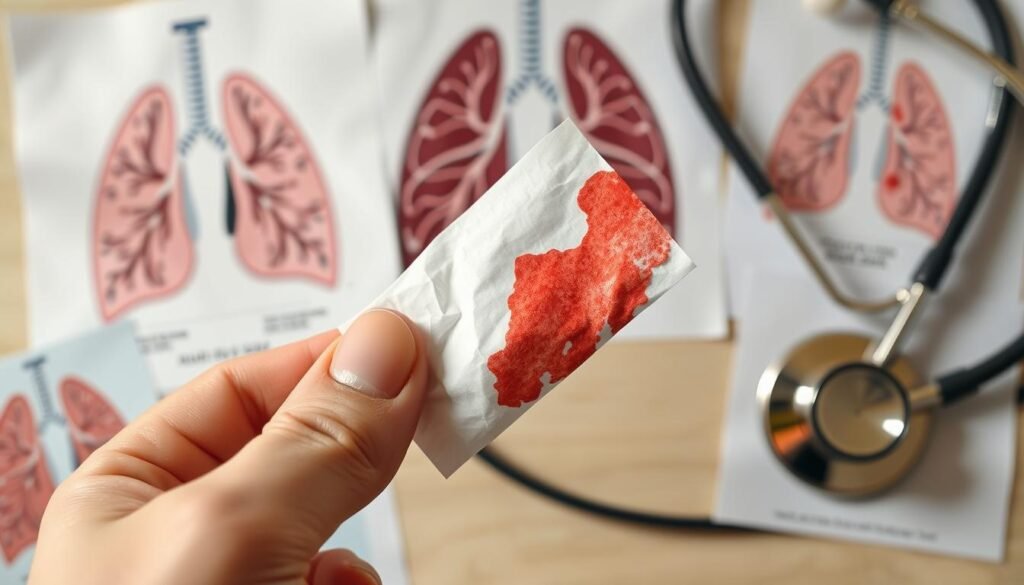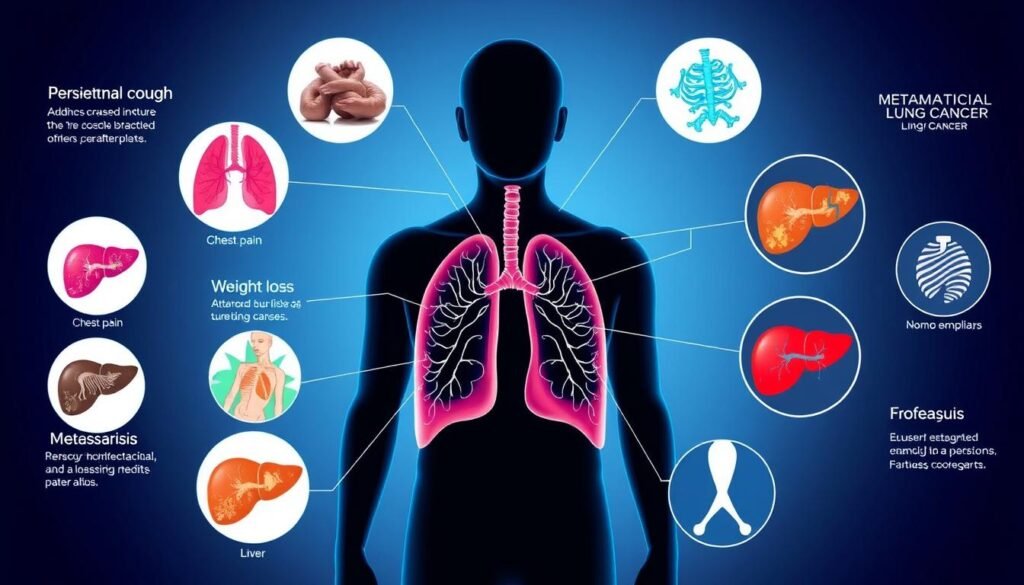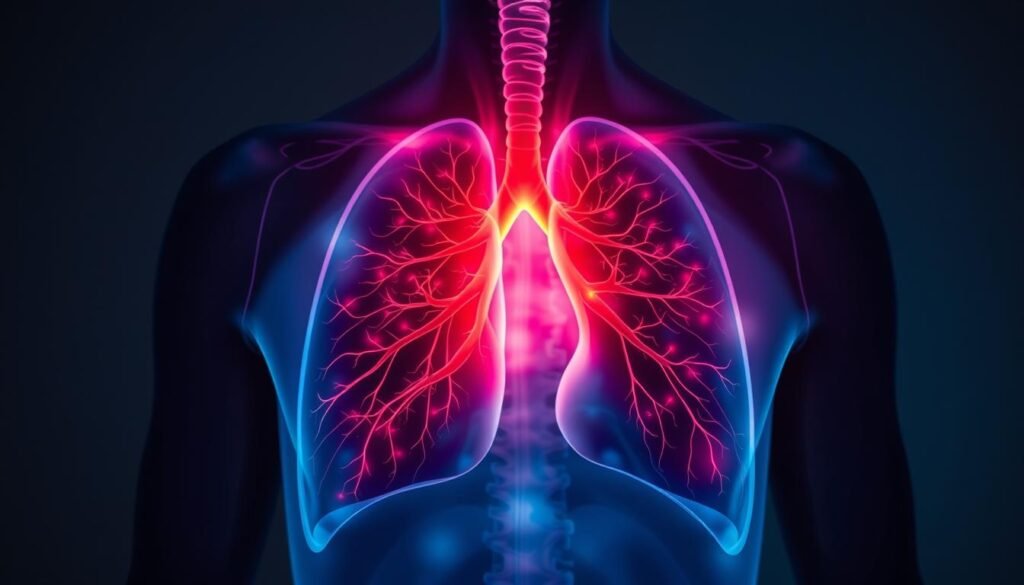Did you know almost 70% of lung cancer cases are found late? This is when symptoms are clearer. It’s vital to know the signs of non-small cell lung cancer (NSCLC) early on. Many people don’t notice symptoms until the cancer grows.
When it gets serious, you might see signs like ongoing cough, pain in the chest, and losing weight without trying. Spotting these early can help treat the disease better. If you know what symptoms to look for, you can get help faster. For more info on symptoms, head to Mayo Clinic’s resource.
Key Takeaways
- Most lung cancers do not show symptoms until they are advanced.
- Early detection through symptom recognition can improve treatment outcomes.
- Persistent cough, chest pain, and weight loss are common lung cancer symptoms.
- Advanced NSCLC may lead to complications such as bone pain and respiratory distress.
- Individuals with a history of smoking are at a significantly higher risk for developing lung cancer.
- Knowing the symptoms can help in seeking timely medical attention.
- Regular screenings may be beneficial for high-risk individuals.
Understanding Non-Small Cell Lung Cancer (NSCLC)
Non-small cell lung cancer, or NSCLC, makes up about 80 to 85 percent of lung cancers. It includes types like adenocarcinoma, squamous cell carcinoma, and large cell carcinoma. Each one differs in how it affects the body and treatment outcomes.
Adenocarcinoma is the most common NSCLC type. It’s found in smokers and non-smokers alike, mainly in the lung’s outer areas. Squamous cell carcinoma usually shows up in those who have smoked, typically near the central airways. Large cell carcinoma can appear anywhere in the lung. It grows fast and is pretty aggressive.
Knowing how slowly NSCLC progresses is key to understand why symptoms might not appear right away. Often, signs don’t show until the cancer is quite advanced. That’s why being aware of different lung cancers and their symptoms is so crucial.
To diagnose NSCLC, doctors use imaging tests like X-rays and CT scans. Treatments can range from surgery to cutting-edge options such as targeted therapy and immunotherapy. These depend on the cancer’s stage and type.
Risk Factors for Advanced NSCLC
It’s very important to know what causes lung cancer so we can prevent it or find it early. Smoking is the biggest cause. It’s linked to 80% of lung cancer deaths. For a type of lung cancer called NSCLC, smoking is even more dangerous. Being around someone else’s smoke can also be harmful. It is the third leading cause of lung cancer in the U.S.
Radon is another big cause of lung cancer. The EPA says it’s second only to smoking. This gas comes from the ground and can get trapped in houses. Around 21,000 lung cancer deaths a year in the U.S. are because of radon. This shows why it’s important to test our homes.
Being around things like asbestos at work can also increase lung cancer risk. People who work with asbestos and smoke are at a very high risk. Other things like arsenic in water and air pollution can also cause lung cancer. But they are not as common as smoking and radon.
If lung cancer runs in your family, you might be more likely to get it too. This suggests genes play a part in NSCLC. Having radiation therapy on the chest increases the risk as well. This is especially true for people who smoke.
Knowing these risks can help us a lot. If we catch lung cancer early or take steps to prevent it, we can save lives.
| Risk Factor | Description | Percentage of Contribution to Lung Cancer |
|---|---|---|
| Smoking | Primary cause of lung cancer deaths, including both active and secondhand smoke exposure | ~80% |
| Radon Exposure | Leading cause of lung cancer after smoking; a colorless gas found indoors | ~21,000 deaths annually |
| Asbestos | Occupational exposure increases lung cancer risk, especially among smokers | Varies |
| Genetic Factors | Family history can elevate the likelihood of developing lung cancer | Varies |
| Radiation Therapy | Previous chest radiation for other cancers raises lung cancer risk | Varies |
| Outdoor Air Pollution | Linked to an increased risk of lung cancer | ~1%-2% of deaths |
Common Symptoms of Lung Cancer
Knowing the signs of lung cancer is key for early detection and starting treatment. Lung cancer symptoms, like those in non-small cell lung cancer (NSCLC), grow slowly. One of the initial signs is often a constant cough without a clear cause. This cough may bring pain in the chest, which might be confused with other health issues.
Coughing and chest pain aren’t the only signs. Fatigue and breathing troubles are also common. Plus, a hoarse voice can point to complications. Noticing these signs early can help get the right medical care sooner. This can improve the chance of a successful treatment.
But, having these symptoms doesn’t mean someone definitely has lung cancer. Still, telling a doctor about them is crucial. It helps in getting the best care and treatment strategy.
Advanced Symptoms of NSCLC
Advanced symptoms of NSCLC can seriously affect your way of life. It’s crucial to notice these signs early. This can lead to action at the right time. Usually, people see worrying symptoms like a constant cough and chest pain. These can get worse. Knowing these signs well helps manage the disease better.
Long-lasting Cough and Chest Pain
A lasting cough can be a key sign of serious NSCLC. As the cancer grows, the cough might hurt more and happen more often. Chest pain can go with this cough. It can feel like a small ache or a sharp pain. These signs can mean the cancer is affecting nearby parts. So, it’s important to watch out for them.
Wheezing and Shortness of Breath
Wheezing and running out of breath are common in late-stage NSCLC. Tumors can block the air paths, making it hard to breathe. This might happen even with simple tasks. Wheezing makes a high noise when you breathe. It shows serious changes in the lungs. If these signs show up, getting checked quickly is key. It might mean the cancer is getting worse.
Hoarseness as a Warning Sign
Hoarseness can signal serious health issues, especially if it’s linked to lung cancer. Roughly 1 in 3 people will experience it sometime. When hoarseness doesn’t get better, it could mean advanced lung cancer.
Many things can cause hoarseness, like vocal cord irritation or tumor pressure in the larynx. It’s key to see hoarseness as an early warning. If you smoke or are at risk for lung cancer, see a doctor if hoarseness lasts more than three weeks.
Doctors may use laryngoscopy, CT scans, or biopsies to check hoarseness. ENT specialists can help find the cause and suggest treatment options. Treatments might include surgery, radiation, or chemotherapy, plus therapies for the vocal cords.
Treating hoarseness at home involves resting your voice and drinking lots of fluids. Avoid smoking and things like alcohol and caffeine to help your voice. Since early lung cancer treatment is most effective, knowing that hoarseness could be a symptom is key for high-risk individuals.
For more details on lung cancer symptoms, check out reputable resources. Visit lung cancer detection guidelines or learn about early signs at comprehensive early signs of lung cancer.
Coughing Up Blood: What It Indicates
Coughing up blood, or hemoptysis, is a critical sign, especially in lung cancer patients. About 20% of people with non-small cell lung cancer (NSCLC) face this troubling symptom. It happens when tumors affect blood vessels or cause major health issues.
In serious cases, coughing up blood can threaten life. Studies reveal that 5% to 15% of NSCLC with hemoptysis are severe. It’s often due to bronchial artery damage. Thus, immediate medical help is vital for those coughing up more than a few teaspoons of blood or if they feel dizzy, have trouble breathing, or chest pains.

Diagnostic tests for lung cancer, like bronchoscopies or lung biopsies, might cause coughing up blood. Various lung cancers can lead to this issue, pointing to the importance of detailed checks and treatment. Early medical advice is key for unexplained hemoptysis. It improves chances with treatments.
Knowing how coughing up blood links to lung cancer symptoms is crucial. It’s emotionally hard but recognizing its seriousness helps in making better health choices. For more on coughing up blood and lung cancer, check this link.
Late-Stage Lung Cancer Symptoms
In its advanced stages, lung cancer causes severe symptoms. Patients often report extreme fatigue, trouble breathing, and a continuous cough. Alongside these, unintentional weight loss is common, showing as a decrease in muscle and body weight from cancer’s effects on metabolism.
Fluid around the lungs can lead to breathing difficulties. Doctors may drain this fluid to provide relief. If fluid keeps building up, treatments like pleurodesis may be needed.
Growth of the tumor can block major airways. This leads to serious issues, including coughing up blood and difficulty breathing. Radiation therapy is one method used to lessen these severe problems.
As the cancer spreads, symptom management becomes crucial. When it reaches the brain, it might cause headaches, seizures, or cognitive problems. Doctors often use radiation and new drugs to control these troubling symptoms.
Pain often affects those in late stages of lung cancer. Managing this pain usually involves radiation and medication to relieve discomfort.
The emotional and spiritual impact of late-stage lung cancer is significant. Patients may withdraw socially and discuss death, showing a need for strong support.
| Symptom | Description |
|---|---|
| Shortness of Breath | Difficulty breathing due to fluid accumulation and tumor obstruction. |
| Persistent Cough | Chronic cough resulting from airway tumors or fluid build-up. |
| Fatigue | Extreme tiredness affecting daily activities and overall quality of life. |
| Unintentional Weight Loss | Significant loss of weight and muscle mass without trying, often linked to cancer cachexia. |
| Pain | Discomfort and pain due to tumor growth and metastasis. |
| Emotional Changes | Withdrawal, irritability, and spiritual distress. |
Metastatic Lung Cancer and Its Indicators
Metastatic lung cancer starts in the lungs and spreads to other body parts. This leads to different symptoms. Knowing these signs is key for quick diagnosis and treatment.
Bone Pain and Associated Symptoms
Bone pain is a major sign of metastatic lung cancer. It means the cancer might have reached the bones. The pain is usually constant and feels dull or aching. You might also notice:
- Localized swelling around the affected bones
- Fractures that occur without significant injury
- Difficulty moving or performing daily activities due to pain
Spotting these symptoms early is critical to better outcomes. They suggest the need for more tests, especially if the pain’s cause is unclear.
Neuro Symptoms from Brain Metastasis
Brain metastasis from lung cancer brings different neuro symptoms. Common signs include headaches, nausea, and vomiting. Other symptoms are:
- Visual field loss
- Weakness in limbs, known as hemiparesis
- Cranial nerve deficits possibly affecting facial sensations
- Seizures in some cases
This condition is more common with adenocarcinoma. It underlines the importance of quick action for any neuro symptoms. If you notice these signs, seek medical advice right away. To learn more, a study here links symptoms and cancer stage.

Superior Vena Cava Syndrome: A Severe Complication
Superior vena cava syndrome (SVCS) is a severe problem for lung cancer patients. Every year, around 15,000 cases pop up in the United States, mainly due to cancers. Lung adenocarcinoma is often the culprit, responsible for more than 85% of these cases.
A tumor pressing on the superior vena cava slows down blood flow. This can lead to:
- Facial swelling
- Neck and arm edema
- Difficulty breathing
Severe issues like downhill esophageal varices and pleural effusions might develop, affecting about 60% of sufferers. These complications usually get better once the blockage is treated.
To find an SVC blockage, doctors often use a CT scan of the chest. This method is very reliable. Endovascular therapy is now the go-to treatment. It offers quick relief with minimal hassle. Sadly, survival rates are low, with less than 10% living over 30 months after finding out they have the syndrome. This fact underlines the critical nature of SVCS in lung cancer.
| Aspect | Details |
|---|---|
| Annual Incidence | Approximately 15,000 cases in the U.S. |
| Associated Malignancies | Lung, breast, and mediastinal neoplasms |
| Common Cause | Adenocarcinoma of the lung |
| Percentage Linked to Malignancy | More than 85% |
| Common Symptoms | Facial swelling, neck and arm edema, difficulty breathing |
| Survival Rate Post-Treatment | Less than 10% survive more than 30 months |
It’s vital to know about superior vena cava syndrome. Early detection and treatment are key in fighting advanced lung cancer.
Recognizing Respiratory Distress
Respiratory distress is a big worry for people with lung cancer. It shows up in different ways, like having a hard time breathing, breathing fast, or needing to use extra muscles to breathe. As lung cancer gets worse, these signs can become more severe.
Noticing changes in how someone breathes is key to spotting respiratory distress. If breathing gets quicker or harder, it might mean the cancer is getting worse. This could be because of fluid around the lungs or something blocking the airway. It’s important for caregivers and doctors to keep an eye out for these changes.
Dealing with respiratory distress early can make life better for someone with lung cancer. Being quick to notice and treat breathing problems means better care. This approach helps avoid bigger problems and makes the treatment path smoother.

| Respiratory Distress Signs | Impact on Patient |
|---|---|
| Difficulties in Breathing | Indicates progression of lung cancer symptoms |
| Rapid Breathing | May signify a need for medical intervention |
| Using Accessory Muscles | Shows increased effort in breathing |
| Fluid Accumulation | Contributes to airway blockage |
| Potential for Complications | Requires prompt diagnosis and management |
Keeping a close watch on breathing problems helps manage lung cancer better. Caregivers are crucial in noticing these issues early on. This ensures patients get the support they need throughout their treatment.
Conclusion
Knowing the signs of advanced NSCLC is key to getting help quickly and improving treatment results. People can face serious symptoms, like ongoing cough and chest pain. They might also experience severe issues such as superior vena cava syndrome (SVCS). Spotting these symptoms early can help people get the medical attention they need and perhaps better their chances.
It’s crucial to raise awareness about lung cancer. This is because around 65% of those diagnosed are already in late stages, which worsens their life quality. Getting familiar with NSCLC symptoms is important. It helps in catching the disease earlier, which can lead to better care for patients. For deeper insights on lung cancer, its causes, and treatment options, check out this resource.
Education on lung cancer can make people more alert to its signs. By understanding NSCLC’s advanced symptoms, patients and doctors can work together better to fight this tough disease. Highlighting the importance of recognizing symptoms in the medical field can lead to better patient outcomes and care that is more tailored to each person.